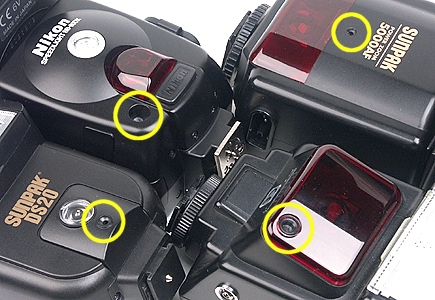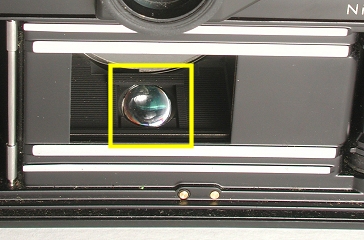When the shutter release button is pressed all the way down to take a photo, the camera will trigger the flash to send out flash burst illuminating the scene. But, how can we determine flash exposure? There are in general three different ways: manual, auto and TTL.
This is the earliest available flash mode. In this mode, the camera only triggers the flash and allows the flash to send out its maximum discharge. In fact, the camera and flash work as two independent pieces of equipment. Other than triggering the flash, the camera does not know how much power the flash will put out. Consequently, the photographer must adjust aperture, shutter speed, and ISO sensitivity based on the characteristics of the flash being used. Normally, with a SLR camera body, the shutter speed is set to a flash synchronization shutter speed, and only use aperture and perhaps ISO sensitivity to fine tune exposure. Most consumer digicams use electronic-mechanical shutters that permit higher synchronization speed.
One can use a flash meter to measure the flash intensity (i.e., exposure value, EV), which is then used to set the camera aperture. This is a common practice in studio work. Or, if you know the GN of your flash, you can (1) select an aperture from which a flash-to-subject distance is computed, and move the flash to that distance; or (2) measure the flash-to-subject distance and compute the aperture to be used. See Basic Functions of an External Flash for computation details.
To make flash exposure calculation easier, a sensor is used for measuring flash intensity. This sensor is activated when the flash is triggered by the camera, and monitors the subject luminance when being illuminated by the flash discharge until it reaches a preset level. Then, the sensor cuts off the flash discharge to provide a correct exposure. This "preset level" is determined by the aperture and ISO sensitivity given to the flash.
Where does this sensor go? The easiest way is to make it available on the front panel of a flash so that the viewing direction of the sensor and the flash discharge direction would be the same. The following image shows the flash sensors of four flashes, from lower-left and clockwise: Sunpak DS-20, Nikon SB-80DX, Sunpak PZ5000AF, and Nikon SB22s. A flash sensor has an angle of view of about 30 degree for light measuring.

Since the flash sensor and flash head point to the same direction, one can move the flash to an off camera position, the sensor still can provide a good reading even the flash head is in bounce position. This capability provides a very good and convenient off camera operation. However, since the "cut off" of flash discharge by the sensor is determined by the aperture and ISO sensitivity being used (on the flash), one must dial in the aperture and ISO sensitivity for the sensor to cut off flash discharge properly.
However, there is a potential problem. Suppose the camera and flash use F8.0 and the F5.6, respectively, and are placed at the same location. When the shutter release button is pressed to take a photo, the flash will discharge and cut off when the illumination is good for F5.6 rather than F8.0 that the camera uses. Since F5.6 is larger than aperture F8.0, this means it requires "less" light to make a correct exposure than F8.0 does, and, hence, the image will be under-exposed. By the same reason, if the flash uses F11.0 which is a smaller aperture than F8.0, the flash will discharge "more" light than what F8.0 actually needs. The result would be an over-exposed image. On the other hand, allowing the flash and camera to use different apertures does have some advantages. For example, in fill flash the flash is usually toned down one stop than the aperture being used by the camera (i.e., F8.0 on camera from an ambient reading, and F5.6 on flash to "fill").
A better alternative is, of course, installing the flash sensor into a camera body. In this way, the camera can tell the flash what aperture and ISO sensitivity are being used. On the other hand, since the sensor is now in a camera, how can the camera instruct the flash to follow its order, especially that the flash is not part of the camera body?
The following image shows a typical installation of the flash sensor. It is in the camera chamber behind the lens, facing the film plane. When the shutter release button is pressed fully to take a photo, the following steps will occur: (1) the shutter opens, (2) the flash discharges, (3) light reflected from the subjects in the scene enters the camera lens and hits the film, (4) the flash sensor, which is facing the film plane, measures the light reflected from the film that is being exposed, and cuts off the flash discharge when reaches the desired level of illumination, and (5) the shutter closes completing the exposure of the current frame. Because the flash sensor measures the light reflected from the film, this way of flash metering is referred to as off the film, also known as OTF. Because the flash sensor measures the light through the camera lens, this particular light metering scheme is referred to as through-the-lens, also known as TTL, metering.

Since the flash is no longer an integrated component of the camera, how could the flash and camera work together to complete an exposure, and how could the sensor (or the camera) cut off the flash discharge? Conceptually, it turns out to be very simple. The flash must respond to two signals sent from the camera: start and stop. When the camera needs the flash, the camera sends the start signal to instruct the flash to discharge. When the scene illumination is sufficient, which is determined by the flash sensor in camera body, the camera sends the stop signal to the flash. Once this stop signal arrives, the flash stops discharging. Therefore, the start an stop signals are sent to the flash in step (2) and step (4), respectively. Consequently, flash discharge is controlled by the camera. Since camera manufacturers have different ways of sending these signals, in general, brand A's flashes cannot be used on brand B's cameras in the TTL mode. Normally, when we see a flash claimed to be brand A TTL compatible, it means that that flash can only recognize the start and stop signals sent by brand A's cameras.
From the above discussion, we see that TTL flash actually consists of two components: (1) a flash sensor that uses through the lens light to determine exposure (i.e., TTL flash metering), and (2) the capability of sending out the start and stop signals to a TTL compatible flash (i.e., TTL flash control). As long as a flash can recognize the start and stop signals through the flash contact, it can start and stop flash discharge, no matter wherever the signals come from (e.g., a camera or a testing device).